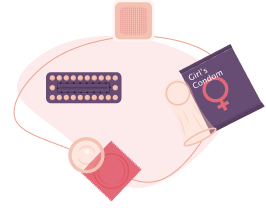
Progestin-only contraceptive implants
Hormonal Method
Progestin-only Contraceptive Implants are commonly referred to as “Implants”.
Implants are one or two small flexible rods that contain the progestin hormone and are inserted under the skin of a woman’s upper arm to give protection against pregnancy for between 3 to 5 years.
How it works
The hormones work by preventing the release of eggs from ovaries and thickening the cervical mucus, which interferes with sperm transport.Common Types of Implants
The common Implants available provide pregnancy prevention for three years, four years and five years.Effectiveness
- Implants provide 99% effective protection against pregnancy.
Advantages
-
- Implants are highly effective and offer long-term protection against pregnancy for upto 3 to 5 years.
- Suitable for women who wish to avoid daily, weekly and monthly contraception regimen.
- In addition, fertility returns almost immediately after implants are removed.


Limitations
- The client cannot initiate or discontinue the method on her own as it requires a trained provider to insert and remove the implant.
- Does not protect against HIV infection (AIDS) and other sexually transmitted infections (STIs).
Side Effects experienced by some users
- When using this method, you may experience some changes in bleeding patterns for example irregular bleeding, heavy or prolonged bleeding, or spotting
- Some women also experience weight changes, headache, dizziness, mood swings, abdominal bloating, acne, or breast tenderness

Juu life ni kujipanga!
Popular questions
You will get a small injection on your arm to numb you. This means you won’t feel pain at all during insertion. There will be a little pain or soreness as the wound heals for about a week.
Yes. A woman who has not had children generally can use an IUD, but she should understand that the IUD is more likely to come out because her uterus may be smaller than the uterus of a woman who has given birth.
Yes. If needed, ECPs can be taken again, even in the same cycle. A woman who needs ECPs often may want to consider a longer-acting and more effective family planning method
Yes. A woman who has not had children generally can use an IUD, but she should understand that the IUD is more likely to come out because her uterus may be smaller than the uterus of a woman who has given birth.
No. Most research finds no major changes in bleeding patterns after female sterilization. If a woman was using a hormonal method or IUD before sterilization, her bleeding pattern will return to the way it was before she used these methods



